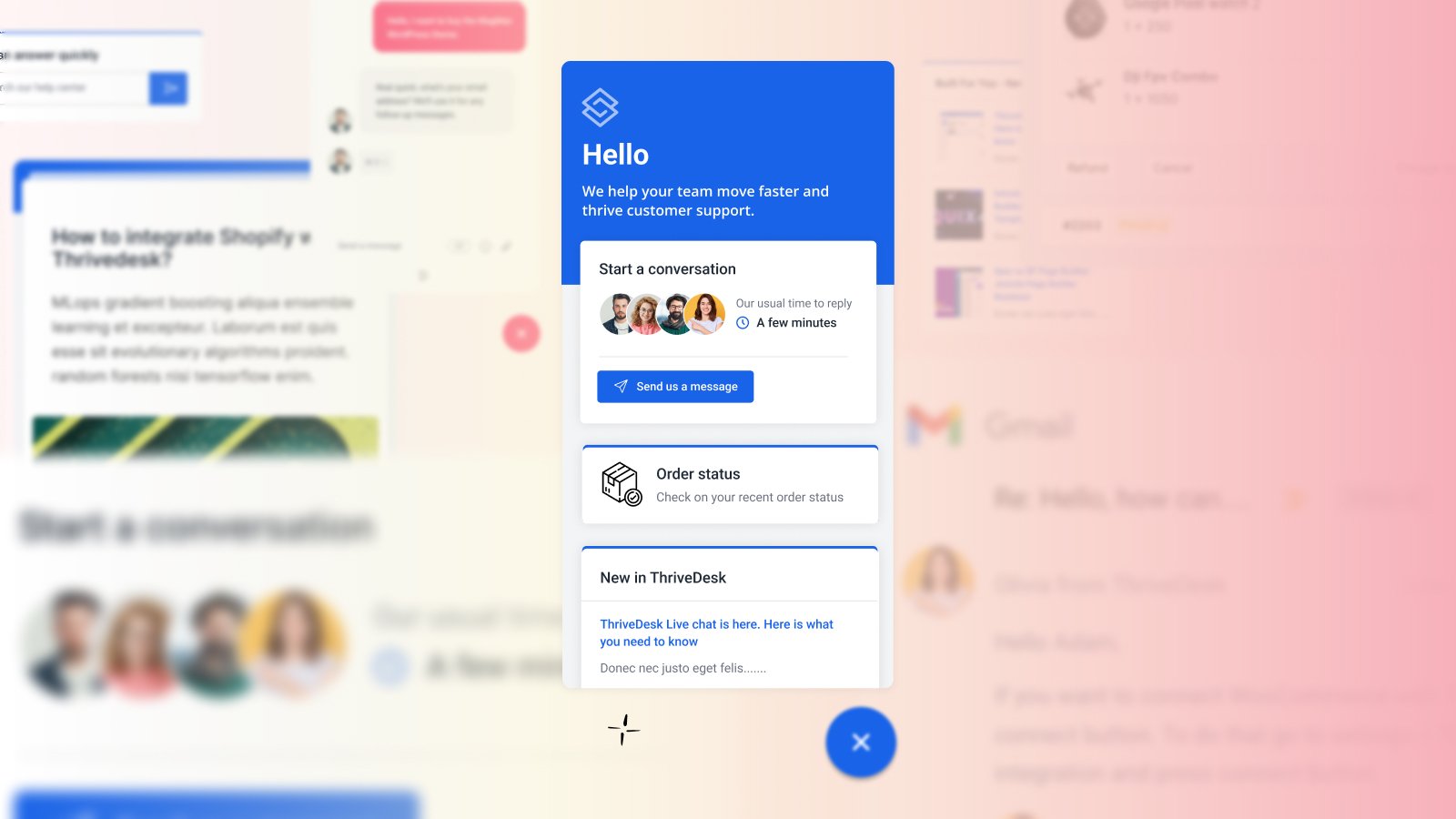I’m not going to start off with some clever analogy to give you a working idea of real time customer service or even a humorous real-life example of how real time customer service is relevant today. Rather, I’ll just hit you with some cold, hard facts.
🟢 The expectation of companies to respond promptly and engage with customers in real-time is shared by 64% of customers. (SurveySparrow)
🟢 Businesses that utilize real-time customer experience strategies are preserving 55% more customers compared to those not employing such methods. (Aberdeen Group Research)
🟢 For each 1% rise in customer satisfaction, there is a corresponding 5% boost in customer retention rates. (SurveySparrow)
🟢 Following an exceptional customer service encounter, 91% of customers express an increased likelihood of making additional purchases. (Salesforce)
🟢 Enterprises that attain higher ratings in customer satisfaction witness a 12% surge in their stock prices. (SurveySparrow)
So what have these facts taught us?
Real time customer service >>> leads to >>> Greater Customer Satisfaction >>> which in turn leads to >>> More $$$!
Real time customer service has become an essential component of modern business operations, reflecting the growing demand from today’s consumers for instant gratification and personalized experiences.
At its core, real time support emphasizes speed and immediacy, enabling companies to address customer inquiries, issues, and concerns in a timely and efficient manner.
This approach represents a significant departure from traditional support methods, such as email and phone, which often involve lengthy wait times and delayed responses.
As customer expectations continue to evolve, real time support has emerged as a powerful tool for businesses to enhance customer satisfaction, build loyalty, and ultimately drive growth by delivering exceptional service at the moment it is needed most.
What is Real Time Customer Service?
Real time customer service refers to the immediate and direct communication between businesses and customers. It focuses on providing instant assistance and resolving issues as they occur. Common channels for real time customer service include live chat, phone calls, video conferencing, and social media.
Here’s a table summarizing the different channels for real time customer service:
| Channel | Description |
|---|---|
| Live chat | Enables customers to chat with a customer service representative in real time through a website or mobile app. |
| Phone calls | Allows customers to speak directly with a customer service representative over the phone. |
| Video conferencing | Provides a face-to-face interaction between customers and customer service representatives through a video call. |
| Social media | Enables customers to connect with businesses and get support through social media platforms like Twitter and Facebook. |
Benefits of Real Time Customer Service
As we’ve already seen, real time customer service isn’t just a trendy buzzword; it has real world implications for businesses of all sizes.
By offering immediate assistance through live chat, social media, messaging apps, and other channels, you can unlock a range of benefits that directly translate to happier customers and a healthier bottom line.
Faster Resolutions, Happier Customers
Imagine a customer encountering a hurdle while trying to complete a purchase. They might face long wait times or frustrating email exchanges in the traditional support landscape. Real time support flips the script. Customers receive prompt assistance, leading to:
Faster resolutions: Customers will no longer have to wait days for a reply. Real time channels allow you to address issues quickly, minimizing customer frustration.
Reduced friction: By providing immediate intervention, you can prevent minor issues from snowballing into larger problems, keeping your customers happy.
Improved overall experience: Convenience and personalized interactions create a more positive experience for your customers, leaving a lasting positive impression.
Building Loyalty Through Responsiveness
The positive impact of real time customer support goes beyond immediate fixes. It fosters trust and loyalty by demonstrating that you value your customers’ time and needs:
Responsiveness that resonates: Customers appreciate a company that prioritizes their needs and offers solutions without delay.
Personalized connections: Real time communication allows for back-and-forth conversations, building a sense of connection and trust with your customers.
Advocates in the making: Satisfied customers are more likely to recommend your brand to others, expanding your reach organically.
Converting Inquiries into Sales
Real-time support isn’t just about resolving issues; it’s about capitalizing on opportunities. By providing immediate assistance during the purchase journey, you can dramatically improve your sales figures and brand loyalty:
Real-time support at the checkout: Imagine a customer on the verge of buying but having a last-minute question. With real time support, you can answer their questions and address any concerns immediately, leading to more conversions and fewer abandoned carts.
Reduced cart abandonment: Don’t let hesitation turn into lost sales. Real time support allows you to clarify doubts and address concerns promptly, minimizing the number of customers who abandon their purchases before completion.
Streamlining Operations and Reducing Costs
Real time customer service isn’t just good for customer satisfaction; it’s good for your wallet too:
Faster issue resolution: Less time spent on back-and-forth communication or escalations means a more efficient customer service team and lower overall costs.
Fewer escalations: Empower your agents to resolve issues efficiently with real-time channels, reducing the need for escalation to higher levels, which can be time-consuming and resource-intensive.
Gaining Valuable Customer Insights for Better Decisions
Real-time interactions are a goldmine of valuable customer feedback. By harnessing this data, you can gain a deeper understanding of your customers’ needs:
Real-time feedback loop: Gain immediate insights into customer needs and pain points. This allows you to identify areas for improvement and address them proactively.
Proactive problem-solving: By identifying recurring issues through real-time interactions, you can address them before they escalate, preventing future customer frustration.
Data-driven decision making: Analyze customer interactions to understand customer behavior and preferences. This allows you to inform product development, optimize marketing strategies, and ultimately create a more customer-centric experience.
Channels for Real Time Customer Service
Real time customer service can be delivered through various channels, each offering unique advantages and considerations. Choosing the right mix of channels is essential to effectively meet your customer base’s diverse needs and preferences.
Live Chat

One of the most popular and widely adopted real time customer support channels, live chat allows customers to initiate conversations directly from a company’s website or mobile app.
The primary advantages of live chat include its convenience, instantaneous response times, and the ability to multi-task while receiving support.
However, businesses must ensure that live chat agents are properly trained in effective written communication, active listening, and problem-solving skills.
AI-powered chatbots and virtual assistants, which can be integrated into live chat systems to handle initial customer inquiries and provide basic support, are an alternative to traditional agents.
These AI tools can respond instantly, reduce wait times, and free up human agents to focus on more complex issues. However, when needed, businesses must ensure a seamless handoff process from AI to human agents.
Best practices for live chat include setting clear response time expectations, providing self-service options for simple inquiries, and seamlessly integrating chat functionality into the overall user experience.
Social Media Support

In today’s social media age, customers often turn to their favored platforms to voice their concerns, seek assistance, or share feedback about brands.
Offering real-time support through channels like Facebook, Twitter, and Instagram has become a necessity for companies to maintain a strong online presence and reputation.
Responding promptly to complaints, direct messages, and complaints can help resolve issues before they escalate and demonstrate a brand’s commitment to exceptional customer service.
Social media support requires a strategic approach, including monitoring relevant platforms, training agents in appropriate tone and language, and leveraging social listening tools to proactively identify and address customer pain points.
There’s scope for AI to play a crucial role in social media monitoring and response management as well.
Natural language processing (NLP) and sentiment analysis tools can automatically identify and prioritize posts, comments, or messages that require immediate attention.
Additionally, AI-driven social media chatbots can provide initial responses and triage inquiries, escalating to human agents when necessary.
Messaging Apps (WhatsApp, SMS)

Messaging applications like WhatsApp and SMS offer a highly personal and convenient channel for real-time support, leveraging the ubiquity of mobile devices.
These channels allow for one-on-one conversations, enabling businesses to provide personalized assistance tailored to individual customers’ needs.
Additionally, messaging apps can facilitate the sharing of multimedia content, such as images or videos, which can be invaluable for troubleshooting or providing visual guidance.
To effectively utilize messaging apps for support, companies should establish clear opt-in processes, implement automated routing and response mechanisms, and ensure compliance with relevant data privacy and security regulations.
Businesses can use Conversational AI chatbots that can be deployed on messaging apps to offer round-the-clock, personalized support.
These AI assistants can handle routine queries, provide information from knowledge bases, and even complete simple tasks or transactions. As with other channels, a smooth transition process to human agents should be in place for more complex issues.
Video Chat

While text-based channels are often suitable for many customer inquiries, certain complex or technical issues may benefit from face-to-face interaction.
Video chat support allows customers and agents to communicate in real time using audio and visual cues, enabling more effective problem-solving and demonstrations.
This channel can be particularly useful for industries like financial services, technology, healthcare , where visual aids and screen sharing can greatly enhance the support experience.
Considerations for video chat support include ensuring stable internet connections, providing appropriate training for agents on effective video communication, and addressing potential privacy concerns.
Co-browsing

Cobrowsing, also known as collaborative browsing or website navigation sharing, is a powerful real-time support tool that enables customer service representatives and customers to navigate a website or application simultaneously.
This channel allows agents to guide customers through complex processes, replicate and resolve technical issues, or provide step-by-step instructions in real time. Cobrowsing can significantly improve the efficiency of issue resolution and reduce frustration for both parties.
However, businesses must carefully implement security measures to protect sensitive customer data and ensure compliance with relevant regulations.
Implementing Real Time Customer Service
Adopting real time customer service requires a strategic and well-planned approach to ensure its successful implementation and long-term sustainability. Here are some key considerations:
Choosing the Right Channels: The first step is to carefully evaluate your target audience and their preferences when it comes to communication channels. Conduct market research, analyze customer data, and gather feedback to understand which real-time support channels resonate most with your customer base.
Additionally, consider your business needs, such as the complexity of your products or services, the volume of inquiries, and the resources available. This analysis will help you prioritize and select the most appropriate channels, whether it’s live chat, social media, messaging apps, video chat, or a combination of these.
Training Customer Support Representatives: Successful real-time support relies heavily on the skills and capabilities of your customer service team. Provide comprehensive training programs that focus on developing active listening skills, clear and concise communication, and effective problem-solving techniques.
Agents should be equipped to navigate real-time interactions with empathy, patience, and a customer-centric mindset. Additionally, ensure that your team is well-versed in your products, services, and industry-specific knowledge to provide accurate and relevant information.
Utilizing Appropriate Technology: Implementing real-time support requires investing in the right technology solutions. This may include robust real-time live chat software with features like co-browsing, screen sharing, and multi-channel integration.
Social media monitoring and management tools can help your team stay on top of conversations across various platforms. Consider implementing a unified customer engagement platform that consolidates all real-time channels into a single interface, enabling seamless agent-customer interactions and efficient case management.
Establishing Clear Guidelines and Procedures: Develop comprehensive guidelines and standard operating procedures (SOPs) to ensure consistency and quality in real-time support delivery. These guidelines should cover areas such as response times, tone and language, escalation protocols, and data privacy and security measures.
Clearly define the roles and responsibilities of your support team, as well as the workflows and processes for handling different types of inquiries or issues. Regular training and reinforcement of these guidelines are essential to maintain high standards of service.
In addition to these core elements, it’s crucial to foster a culture of continuous improvement within your organization. Regularly solicit customer feedback, analyze performance metrics, and identify areas for optimization. Encourage open communication and collaboration among your support team to share best practices and address emerging challenges promptly.
By carefully considering your audience, investing in the right resources (training and technology), and establishing robust processes, you can lay a solid foundation for successful real time customer service implementation. This strategic approach will enable you to deliver exceptional real-time experiences that drive customer satisfaction, loyalty, and business growth.
The Role of Self-Service in Real Time Support
While real time customer service channels are essential for addressing complex inquiries and providing personalized assistance, self-service options can complement these efforts by empowering customers to find solutions independently. Incorporating self-service into your support strategy can not only enhance the overall customer experience but also optimize resource allocation and reduce the strain on your support team.
Knowledge Base
A well-curated knowledge base serves as a comprehensive library of information, housing frequently asked questions (FAQs), tutorials, troubleshooting guides, and best practices.
By providing customers with access to this wealth of knowledge, you enable them to find answers quickly and efficiently without the need for immediate human intervention.
An effective knowledge base should be easily searchable, organized by product or service categories, and regularly updated with new content to ensure accuracy and relevance.
An example is ThriveDesk. ThriveDesk’s user-friendly knowledge base software consolidates product details and troubleshooting materials, facilitating customer self-help. With features such as customizable portals, multi-channel delivery, and insightful analytics, businesses can streamline support operations effectively.
As an innovative platform, we are actively enhancing our capabilities by integrating AI to automate mundane tasks, further enhancing personalized user experiences. ThriveDesk is at the forefront of delivering delightful customer service and comprehensive knowledge management that is easily accessible at your fingertips.
Chatbots
Chatbots in live chat, powered by artificial intelligence and natural language processing, can play a pivotal role in real-time self-service support.
These virtual assistants can engage with customers through conversational interfaces, understanding and responding to their inquiries with automated yet contextual responses. Chatbots can handle basic queries, provide information from knowledge bases, and even complete simple tasks or transactions.
Chatbots can provide immediate assistance by offering 24/7 availability, reducing wait times, and increasing customer satisfaction. However, designing chatbots with a clear escalation path is essential, enabling seamless transitions to human agents for more complex or sensitive issues.
Interactive Voice Response (IVR)
For businesses that rely on phone support, Interactive Voice Response (IVR) systems can streamline the self-service experience for customers.
IVR systems use pre-recorded voice prompts and touch-tone or speech recognition to guide customers through a menu of options, allowing them to access information, perform simple transactions, or route their call to the appropriate support agent.
Advanced IVR systems can leverage natural language processing and conversational AI to provide a more intuitive and personalized self-service experience.
Effective self-service options not only empower customers but also benefit businesses by reducing the volume of routine inquiries handled by support teams.
This, in turn, allows customer service representatives to focus on more complex issues that require human expertise and personalized attention.
However, it’s crucial to balance self-service and real-time support, ensuring that customers can seamlessly transition to human agents when needed.
To maximize the effectiveness of self-service in real-time support, businesses should regularly analyze customer feedback, usage patterns, and performance metrics.
This data can inform continuous improvements, such as enhancing knowledge base content, optimizing chatbot conversations, or refining IVR menus and prompts.
Additionally, promoting self-service options and providing clear guidance on how to access and utilize them can further enhance the overall customer experience.
By integrating self-service into your real-time support strategy, you can offer customers a comprehensive array of assistance options, catering to their diverse needs and preferences while optimizing resource allocation and driving operational efficiency.
Measuring the Success of Real Time Customer Service
Implementing real time customer service is just the first step; measuring its effectiveness and continuously refining your approach is equally crucial. By establishing clear performance metrics and monitoring key indicators, businesses can gauge the impact of their real-time support efforts, identify areas for improvement, and optimize processes for maximum effectiveness.
Key Performance Indicators (KPIs):
Several KPIs can provide valuable insights into the success of your real-time support strategy:
- Average Resolution Time (ART): This metric measures the average time it takes for customer inquiries or issues to be resolved, from the initial contact to the final resolution. Lower ART indicates faster and more efficient support, which can lead to higher customer satisfaction.
- Customer Satisfaction Score (CSAT): CSAT surveys or ratings allow customers to provide feedback on their overall experience with the real-time support interaction. High CSAT scores signify that customers are satisfied with the quality of support they received, reflecting positively on your brand and fostering loyalty.
- First Contact Resolution (FCR): This KPI tracks the percentage of customer inquiries or issues resolved during the initial interaction, without the need for follow-up contacts or escalations. A high FCR rate indicates that your support agents are equipped with the necessary knowledge and skills to address customer concerns effectively on the first attempt.
Analyzing Customer Feedback:
In addition to quantitative metrics, qualitative customer feedback can provide invaluable insights into the real-time support experience. Actively solicit feedback through post-interaction surveys, social media monitoring, or dedicated feedback channels. Analyze this feedback to identify recurring themes, pain points, or areas where customers feel your real-time support efforts could be improved.
Continuous Optimization:
Measuring success is not a one-time exercise; it should be an ongoing process of continuous improvement. Based on your KPI data and customer feedback analysis, take proactive steps to refine and optimize your real-time support processes:
- Identify and address training gaps for your support team, ensuring they have the necessary skills and knowledge to provide exceptional real-time assistance.
- Evaluate and enhance your technology stack, exploring new tools or features that can streamline real-time support delivery and improve the overall customer experience.
- Refine your support workflows and processes, eliminating bottlenecks or inefficiencies that may be hindering timely resolutions or causing customer frustration.
- Continuously update and enrich your knowledge base, self-service resources, and AI-powered assistance to ensure customers have access to the latest information and can find answers independently when possible.
- Foster a culture of continuous learning and improvement within your support team, encouraging collaboration, sharing of best practices, and ongoing professional development.
By regularly measuring and analyzing key performance indicators, gathering customer feedback, and implementing data-driven optimizations, businesses can continually enhance their real-time support offering. This iterative approach not only drives operational efficiency but also fosters a customer-centric culture that prioritizes exceptional service and satisfaction.
The Future of Real Time Customer Service

As technology continues to evolve and customer expectations shift, the landscape of real-time support is poised for significant advancements. These advancements will be driven by the convergence of artificial intelligence (AI), data analytics, and omnichannel integration, enabling businesses to deliver more proactive, personalized, and seamless customer support experiences.
The Rise of AI-Powered Chatbots and Virtual Assistants
As discussed previously, AI-powered chatbots and virtual assistants are already playing a vital role in augmenting real-time support across various channels.
However, the future holds even greater potential for these AI-driven technologies.
With advancements in natural language processing, machine learning, and conversational AI, chatbots and virtual assistants will become increasingly sophisticated, capable of understanding complex queries, providing nuanced responses, and even exhibiting emotional intelligence.
These AI assistants will not only handle routine inquiries but also assist with more complex tasks, such as troubleshooting, product recommendations, and personalized advice.
They will seamlessly integrate with other AI-powered systems, such as predictive analytics and knowledge management platforms, to deliver customers more accurate and contextually relevant information.
Integration with Omnichannel Platforms for Seamless Customer Journeys
In the future, real-time support will be deeply integrated into omnichannel customer engagement platforms, enabling seamless transitions across various touchpoints.
Customers will be able to initiate support interactions through their preferred channels, whether it’s a website, mobile app, social media, or messaging platform, and continue the conversation without interruption or the need to repeat information.
This omnichannel approach will not only provide a cohesive and consistent support experience but also enable businesses to capture and leverage customer data from multiple sources.
By analyzing this data, companies can gain valuable insights into customer behavior, preferences, and pain points, enabling them to proactively address issues and deliver personalized support experiences.
Proactive and Personalized Support Based on Customer Data and Behavior
The future of real time customer service will be driven by a proactive and personalized approach, enabled by the effective utilization of customer data and behavior analytics.
By leveraging AI and machine learning algorithms, businesses will be able to anticipate customer needs, identify potential issues or friction points, and take proactive measures to address them before they escalate.
For example, predictive models could analyze a customer’s browsing patterns, purchase history, and previous support interactions to identify potential areas of concern or confusion. Real-time support could then be triggered through the customer’s preferred channel, offering personalized assistance or guidance tailored to their specific situation.
Furthermore, real-time support will become increasingly contextual, with AI-powered systems able to understand and adapt to individual customer preferences, communication styles, and emotional states. This level of personalization will not only enhance the overall customer experience but also foster stronger brand loyalty and advocacy.
Real time customer service will continue to evolve as we look to the future, driven by technological advancements and changing customer expectations.
By embracing AI, leveraging data analytics, and integrating omnichannel platforms, businesses can position themselves at the forefront of this evolution, delivering exceptional real-time support experiences that drive customer satisfaction, loyalty, and long-term success.
Final Thoughts
Providing real time customer service is critical in today’s fast-paced business world. Channels like live chat, social media, messaging apps, video chat, and co-browsing enable businesses to address customer needs swiftly, boosting satisfaction and loyalty.
However, implementing an effective real-time support strategy requires careful planning – choosing the right channels, training staff, utilizing the appropriate technology, and establishing clear processes. Integrating self-service options like knowledge bases and chatbots can further empower customers.
Continuous measurement and optimization are key. Monitoring metrics like resolution times, customer satisfaction scores, and first-contact resolution rates allows businesses to identify areas for improvement. Analyzing customer feedback provides deeper insights to refine processes, technology, and training.
The future is bright as more advanced technologies powered by AI seep into more facets of real time customer support. Starting from data analytics to all the way to personalized assistance for individual customers.
To stay competitive, businesses must embrace real-time support strategies and adapt to emerging technologies. Investing in these capabilities will enhance customer experiences, drive efficiency, and foster long-term success in an ever-evolving landscape. Continuous improvement is essential to delivering exceptional real-time service that exceeds customer expectations.





